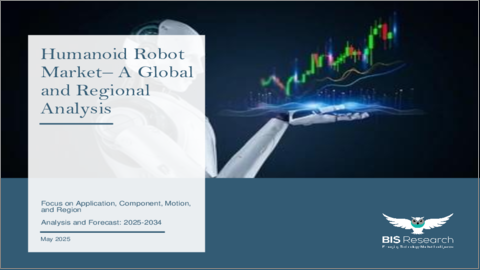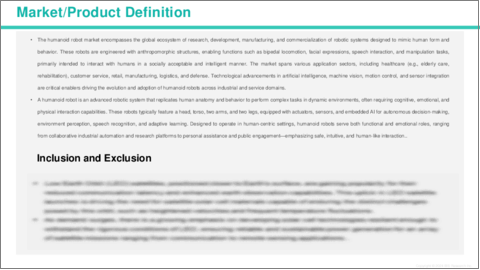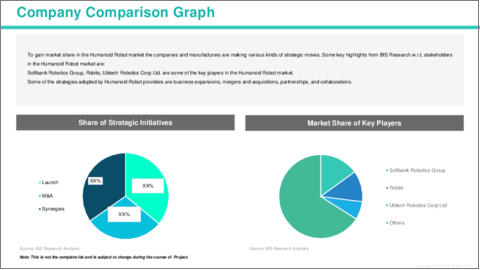|
|
市場調査レポート
商品コード
1722126
ヒューマノイドロボットの世界市場:用途・コンポーネント・モーション・地域別の分析・予測 (2025~2034年)Humanoid Robot Market - A Global and Regional Analysis: Focus on Application, Component, Motion, and Region - Analysis and Forecast, 2025-2034 |
||||||
カスタマイズ可能
|
|||||||
| ヒューマノイドロボットの世界市場:用途・コンポーネント・モーション・地域別の分析・予測 (2025~2034年) |
|
出版日: 2025年05月12日
発行: BIS Research
ページ情報: 英文 120 Pages
納期: 1~5営業日
|
全表示
- 概要
- 図表
- 目次
ヒューマノイドロボティクス産業は、大きく3つの主要セグメントに分かれて構成されています。
まず上流セグメントでは、フレームレストルクモーターやホローカップモーター、精密減速機、高エネルギー密度バッテリー、高度なセンサー (ビジョン、LiDAR、力/トルクセンサー) 、専用AIプロセッサ、高密度プリント基板 (PCB) などの主要コンポーネントが供給されます。中流セグメントでは、Boston Dynamics、Tesla、Agility Roboticsなどのメーカーが、これらの部品を統合しヒューマノイドロボットのプラットフォーム全体を構築します。下流セグメントでは、システムインテグレーターやエンドユーザーによって、製造業、物流、教育、医療、サービス業といった各分野での導入・活用が行われています。
技術面では、高トルク・軽量比を実現する電動アクチュエーション技術、マルチモーダル知覚センサーの配列、そしてROS (Robot Operating System) ベースの制御ソフトウェアに大規模言語モデルやデジタルツインシミュレーションを組み合わせたAI駆動制御技術の進展により、ロボットの適応性、自律性、安全性が大きく向上しています。さらに、クラウドロボティクスの枠組みにより、OTAによるソフトウェア更新、遠隔フリート監視、ロボット間の集団学習が可能となり、機能向上の加速と導入リスクの低減が実現されています。
| 主要市場統計 | |
|---|---|
| 予測期間 | 2025-2034年 |
| 2025年評価 | 29億7,000万米ドル |
| 2034年予測 | 159億8,000万米ドル |
| CAGR | 20.56% |
現在、ヒューマノイドロボット市場は顕著な成長初期段階にあり、試験導入の段階を超えて、本格的な商業展開へと移行しつつあります。この段階は、2025年までに50%超の前年比成長率、ロボティクス分野の先駆者と産業用OEMとの戦略的提携の増加、ベンチャー投資や特許出願の活発化といった動向により裏付けられています。自律性の信頼性、システムの安全性、総所有コスト (TCO) といった主要な障壁が徐々に克服されていく中で、この市場は2020年代後半には、より成熟した成長段階へと移行すると予測されています。それに伴い、教育、医療、サービス分野への導入が拡大し、競争環境も多様化していく見込みです。
当レポートでは、世界のヒューマノイドロボットの市場を調査し、主要動向、市場影響因子の分析、法規制環境、技術・特許の動向、ケーススタディ、市場規模の推移・予測、各種区分・地域/主要国別の詳細分析、競合情勢、主要企業のプロファイルなどをまとめています。
目次
エグゼクティブサマリー
第1章 市場:業界展望
- 動向:現状と将来への影響評価
- ステークホルダー分析
- 使用事例
- エンドユーザーと購入基準
- 市場力学の概要
- 市場促進要因
- 市場抑制要因
- 市場機会
- 規制および政策影響分析
- 特許分析
- スタートアップの情勢
- 総潜在市場
- 投資情勢と研究開発動向
- 将来の展望と市場ロードマップ
- バリューチェーン分析
- 世界の価格分析
- 業界の魅力
第2章 ヒューマノイドロボット市場:用途別
- 用途のセグメンテーション
- 用途のサマリー
- ヒューマノイドロボット市場 (用途別)
- 調査・宇宙探査
- 教育・エンターテイメント
- パーソナルアシスタンス・介護
- ホスピタリティ
- 捜索救助
- その他
第3章 ヒューマノイドロボット市場:製品別
- 製品セグメンテーション
- 製品サマリー
- ヒューマノイドロボット市場 (コンポーネント別)
- ハードウェア
- ソフトウェア
- サービス
- ヒューマノイドロボット市場 (モーション別)
- 二足歩行
- ホイール駆動
第4章 ヒューマノイドロボット市場:地域別
- ヒューマノイドロボット市場 (地域別)
- 北米
- 地域概要
- 市場成長の原動力
- 市場課題
- 主要企業
- 用途
- 製品
- 北米 (国別)
- 欧州
- 地域概要
- 市場成長の原動力
- 市場課題
- 主要企業
- 用途
- 製品
- 欧州 (国別)
- アジア太平洋
- 地域概要
- 市場成長の原動力
- 市場課題
- 主要企業
- 用途
- 製品
- アジア太平洋 (国別)
- その他の地域
- 地域概要
- 市場成長の原動力
- 市場課題
- 主要企業
- 用途
- 製品
- その他の地域 (地域別)
第5章 市場-競合ベンチマーキングと企業プロファイル
- 次のフロンティア
- 地理的評価
- 企業プロファイル
- Softbank Robotics Group
- Robotis
- Ubtech Robotics Corp Ltd.
- PAL Robotics
- Agility Robotics
- Kawada Robotics Corporation
- Toyota Motor Corporation
- Honda Motor Co., Ltd.
- Hason Robotics Ltd.
- Hyulium Robot
- SAMSUNG
- TESLA
- その他の主要企業
第6章 調査手法
List of Figures
- Figure 1: Humanoid Robot Market (by Scenario), $Million, 2025, 2028, and 2034
- Figure 2: Humanoid Robot Market (by Region), $Million, 2024, 2027, and 2034
- Figure 3: Humanoid Robot Market (by Application), $Million, 2024, 2027, and 2034
- Figure 4: Humanoid Robot Market (by Product), $Million, 2024, 2027, and 2034
- Figure 5: Competitive Landscape Snapshot
- Figure 6: Supply Chain Analysis
- Figure 7: Value Chain Analysis
- Figure 8: Patent Analysis (by Country), January 2021-April 2025
- Figure 9: Patent Analysis (by Company), January 2021-April 2025
- Figure 10: Impact Analysis of Market Navigating Factors, 2024-2034
- Figure 11: U.S. Humanoid Robot Market, $Million, 2024-2034
- Figure 12: Canada Humanoid Robot Market, $Million, 2024-2034
- Figure 13: Mexico Humanoid Robot Market, $Million, 2024-2034
- Figure 14: Germany Humanoid Robot Market, $Million, 2024-2034
- Figure 15: France Humanoid Robot Market, $Million, 2024-2034
- Figure 16: Italy Humanoid Robot Market, $Million, 2024-2034
- Figure 17: Spain Humanoid Robot Market, $Million, 2024-2034
- Figure 18: U.K. Humanoid Robot Market, $Million, 2024-2034
- Figure 19: Rest-of-Europe Humanoid Robot Market, $Million, 2024-2034
- Figure 20: China Humanoid Robot Market, $Million, 2024-2034
- Figure 21: Japan Humanoid Robot Market, $Million, 2024-2034
- Figure 22: India Humanoid Robot Market, $Million, 2024-2034
- Figure 23: South Korea Humanoid Robot Market, $Million, 2024-2034
- Figure 24: Rest-of-Asia-Pacific Humanoid Robot Market, $Million, 2024-2034
- Figure 25: South America Humanoid Robot Market, $Million, 2024-2034
- Figure 26: Middle East and Africa Humanoid Robot Market, $Million, 2024-2034
- Figure 27: Strategic Initiatives (by Company), 2021-2025
- Figure 28: Share of Strategic Initiatives, 2021-2025
- Figure 29: Data Triangulation
- Figure 30: Top-Down and Bottom-Up Approach
- Figure 31: Assumptions and Limitations
List of Tables
- Table 1: Market Snapshot
- Table 2: Opportunities across Region
- Table 3: Trends Overview
- Table 4: Humanoid Robot Market Pricing Forecast, 2024-2034
- Table 5: Application Summary (by Application)
- Table 6: Product Summary (by Product)
- Table 7: Humanoid Robot Market (by Region), $Million, 2024-2034
- Table 8: North America Humanoid Robot Market (by Application), $Million, 2024-2034
- Table 9: North America Humanoid Robot Market (by Product), $Million, 2024-2034
- Table 10: U.S. Humanoid Robot Market (by Application), $Million, 2024-2034
- Table 11: U.S. Humanoid Robot Market (by Product), $Million, 2024-2034
- Table 12: Canada Humanoid Robot Market (by Application), $Million, 2024-2034
- Table 13: Canada Humanoid Robot Market (by Product), $Million, 2024-2034
- Table 14: Mexico Humanoid Robot Market (by Application), $Million, 2024-2034
- Table 15: Mexico Humanoid Robot Market (by Product), $Million, 2024-2034
- Table 16: Europe Humanoid Robot Market (by Application), $Million, 2024-2034
- Table 17: Europe Humanoid Robot Market (by Product), $Million, 2024-2034
- Table 18: Germany Humanoid Robot Market (by Application), $Million, 2024-2034
- Table 19: Germany Humanoid Robot Market (by Product), $Million, 2024-2034
- Table 20: France Humanoid Robot Market (by Application), $Million, 2024-2034
- Table 21: France Humanoid Robot Market (by Product), $Million, 2024-2034
- Table 22: Italy Humanoid Robot Market (by Application), $Million, 2024-2034
- Table 23: Italy Humanoid Robot Market (by Product), $Million, 2024-2034
- Table 24: Spain Humanoid Robot Market (by Application), $Million, 2024-2034
- Table 25: Spain Humanoid Robot Market (by Product), $Million, 2024-2034
- Table 26: U.K. Humanoid Robot Market (by Application), $Million, 2024-2034
- Table 27: U.K. Humanoid Robot Market (by Product), $Million, 2024-2034
- Table 28: Rest-of-Europe Humanoid Robot Market (by Application), $Million, 2024-2034
- Table 29: Rest-of-Europe Humanoid Robot Market (by Product), $Million, 2024-2034
- Table 30: Asia-Pacific Humanoid Robot Market (by Application), $Million, 2024-2034
- Table 31: Asia-Pacific Humanoid Robot Market (by Product), $Million, 2024-2034
- Table 32: China Humanoid Robot Market (by Application), $Million, 2024-2034
- Table 33: China Humanoid Robot Market (by Product), $Million, 2024-2034
- Table 34: Japan Humanoid Robot Market (by Application), $Million, 2024-2034
- Table 35: Japan Humanoid Robot Market (by Product), $Million, 2024-2034
- Table 36: India Humanoid Robot Market (by Application), $Million, 2024-2034
- Table 37: India Humanoid Robot Market (by Product), $Million, 2024-2034
- Table 38: South Korea Humanoid Robot Market (by Application), $Million, 2024-2034
- Table 39: South Korea Humanoid Robot Market (by Product), $Million, 2024-2034
- Table 40: Rest-of-Asia-Pacific Humanoid Robot Market (by Application), $Million, 2024-2034
- Table 41: Rest-of-Asia-Pacific Humanoid Robot Market (by Product), $Million, 2024-2034
- Table 42: Rest-of-the-World Humanoid Robot Market (by Application), $Million, 2024-2034
- Table 43: Rest-of-the-World Humanoid Robot Market (by Product), $Million, 2024-2034
- Table 44: South America Humanoid Robot Market (by Application), $Million, 2024-2034
- Table 45: South America Humanoid Robot Market (by Product), $Million, 2024-2034
- Table 46: Middle East and Africa Humanoid Robot Market (by Application), $Million, 2024-2034
- Table 47: Middle East and Africa Humanoid Robot Market (by Product), $Million, 2024-2034
- Table 48: Market Share
Global Humanoid Robot Market: Industry Overview
The humanoid robotics industry is structured into three key segments: an upstream tier supplying core components, frameless torque and hollow?cup motors, precision reducers, power?dense batteries, advanced sensors (vision, LiDAR, force/torque), specialized AI processors, and high?density PCBs; a midstream tier where manufacturers (e.g., Boston Dynamics, Tesla, Agility Robotics) integrate these elements into complete humanoid platforms; and a downstream tier encompassing system integrators and end-use deployments across manufacturing, logistics, education, healthcare, and service sectors. Technologically, advances in electric actuation (delivering high torque?to?weight ratios), multi-modal perception arrays, and AI-driven control software, often built on ROS architectures and augmented by large-language models and digital twin simulations, are significantly enhancing robot adaptability, autonomy, and safety. Complementing on-board intelligence, cloud-robotics frameworks now enable over-the-air software updates, remote fleet monitoring, and collective learning, accelerating capability improvements and reducing deployment risk.
Humanoid Robot Market Lifecycle Stage
| KEY MARKET STATISTICS | |
|---|---|
| Forecast Period | 2025 - 2034 |
| 2025 Evaluation | $2.97 Billion |
| 2034 Forecast | $15.98 Billion |
| CAGR | 20.56% |
Currently, the humanoid robot market is in a pronounced early growth stage, moving beyond pilot deployments into scaled commercial roll-outs. This phase is evidenced by high year-on-year growth rates (over 50% through 2025) and increasing venture funding, patent filings, and strategic alliances between robotics pioneers and industrial OEMs. As key barriers-such as autonomy reliability, system safety, and total cost of ownership-are incrementally overcome, the market is expected to transition into a more mature growth phase by the late 2020s, with broader adoption across education, healthcare, and service sectors fostering a diversified competitive landscape.
Humanoid Robot Market Segmentation:
Segmentation 1: by Application
- Research and Space Exploration
- Education and Entertainment
- Personal Assistance and Caregiving
- Hospitality
- Search & Rescue
- Others
Personal Assistance and Caregiving is one of the prominent application segments in the global humanoid robot market.
Segmentation 2: by Component
- Hardware
- Sensors
- Actuators
- Power Systems
- Control Systems/Controllers
- Others
- Software
- Services
The global humanoid robot market is estimated to be led by the software based segment in terms of component.
Segmentation 3: by Motion
- Biped
- Wheel-drive
Segmentation 4: by Region
- North America - U.S., Canada, and Mexico
- Europe - Germany, France, Italy, Spain, U.K., and Rest-of-Europe
- Asia-Pacific - China, Japan, South Korea, India, and Rest-of-Asia-Pacific
- Rest-of-the-World - South America and Middle East and Africa
In the humanoid robot market, North America is anticipated to gain traction in terms of production, with increasing infrastructure demand and govement initiatives.
Demand - Drivers and Limitations
The following are the demand drivers for the global humanoid robot market:
- Increasing Demand for Humanoids in Educational Sector
The global humanoid robot market is expected to face some limitations as well due to the following challenges:
- Performance Limitations of Humanoid Robots
Humanoid Robot Market Key Players and Competition Synopsis
The humanoid robot market is characterized by intense competition among specialized robotics firms and major technology and automotive entrants. Leading vendors include SoftBank Robotics, Agility Robotics, Boston Dynamics, UBTECH Robotics, Pal Robotics, Hanson Robotics and ROBOTIS, alongside automotive-backed initiatives from Tesla, Toyota and Hyundai. These players differentiate through advanced AI-driven autonomy, payload capacity, human-robot interaction interfaces and safety certifications, while strategic partnerships with manufacturers, logistics providers and research institutions bolster deployment pipelines. Concurrently, substantial venture funding, patent activity and mergers particularly between U.S. innovators and Chinese hardware manufacturers-underscore a race to capture growing demand across industrial, service and educational applications.
Some of the prominent established names in this market are:
- Softbank Robotics Group
- Robotis
- Ubtech Robotics Corp Ltd.
- PAL Robotics
- Agility Robotics
- Kawada Robotics Corporation
- Toyota Motor Corporation
- Honda Motor Co., Ltd
- Hason Robotics Ltd.
- Hyulium Robot
- SAMSUNG
- TESLA
Companies that are not a part of the previously mentioned pool have been well represented across different sections of the report (wherever applicable).
Table of Contents
Executive Summary
Scope and Definition
Market/Product Definition
Key Questions Answered
Analysis and Forecast Note
1. Markets: Industry Outlook
- 1.1 Trends: Current and Future Impact Assessment
- 1.2 Stakeholder Analysis
- 1.2.1 Use Case
- 1.2.2 End User and Buying Criteria
- 1.3 Market Dynamics Overview
- 1.3.1 Market Drivers
- 1.3.2 Market Restraints
- 1.3.3 Market Opportunities
- 1.4 Regulatory & Policy Impact Analysis
- 1.5 Patent Analysis
- 1.6 Start-Up Landscape
- 1.7 Total Addressable Market
- 1.8 Investment Landscape and R&D Trends
- 1.9 Future Outlook and Market Roadmap
- 1.10 Value Chain Analysis
- 1.11 Global Pricing Analysis
- 1.12 Industry Attractiveness
2. Humanoid Robot Market (by Application)
- 2.1 Application Segmentation
- 2.2 Application Summary
- 2.3 Humanoid Robot Market (by Application)
- 2.3.1 Research and Space Exploration
- 2.3.2 Education and Entertainment
- 2.3.3 Personal Assistance and Caregiving
- 2.3.4 Hospitality
- 2.3.5 Search & Rescue
- 2.3.6 Others
3. Humanoid Robot Market (by Product)
- 3.1 Product Segmentation
- 3.2 Product Summary
- 3.3 Humanoid Robot Market (by Component)
- 3.3.1 Hardware
- 3.3.1.1 Sensors
- 3.3.1.2 Actuators
- 3.3.1.3 Power Systems
- 3.3.1.4 Control Systems/Controllers
- 3.3.1.5 Others
- 3.3.2 Software
- 3.3.3 Services
- 3.3.1 Hardware
- 3.4 Humanoid Robot Market (by Motion)
- 3.4.1 Biped
- 3.4.2 Wheel-drive
4. Humanoid Robot Market (by Region)
- 4.1 Humanoid Robot Market (by Region)
- 4.2 North America
- 4.2.1 Regional Overview
- 4.2.2 Driving Factors for Market Growth
- 4.2.3 Factors Challenging the Market
- 4.2.4 Key Companies
- 4.2.5 Application
- 4.2.6 Product
- 4.2.7 North America (by Country)
- 4.2.7.1 U.S.
- 4.2.7.1.1 Market by Application
- 4.2.7.1.2 Market by Product
- 4.2.7.2 Canada
- 4.2.7.2.1 Market by Application
- 4.2.7.2.2 Market by Product
- 4.2.7.3 Mexico
- 4.2.7.3.1 Market by Application
- 4.2.7.3.2 Market by Product
- 4.2.7.1 U.S.
- 4.3 Europe
- 4.3.1 Regional Overview
- 4.3.2 Driving Factors for Market Growth
- 4.3.3 Factors Challenging the Market
- 4.3.4 Key Companies
- 4.3.5 Application
- 4.3.6 Product
- 4.3.7 Europe (by Country)
- 4.3.7.1 Germany
- 4.3.7.1.1 Market by Application
- 4.3.7.1.2 Market by Product
- 4.3.7.2 France
- 4.3.7.2.1 Market by Application
- 4.3.7.2.2 Market by Product
- 4.3.7.3 Italy
- 4.3.7.3.1 Market by Application
- 4.3.7.3.2 Market by Product
- 4.3.7.4 Spain
- 4.3.7.4.1 Market by Application
- 4.3.7.4.2 Market by Product
- 4.3.7.5 U.K.
- 4.3.7.5.1 Market by Application
- 4.3.7.5.2 Market by Product
- 4.3.7.6 Rest-of-Europe
- 4.3.7.6.1 Market by Application
- 4.3.7.6.2 Market by Product
- 4.3.7.1 Germany
- 4.4 Asia-Pacific
- 4.4.1 Regional Overview
- 4.4.2 Driving Factors for Market Growth
- 4.4.3 Factors Challenging the Market
- 4.4.4 Key Companies
- 4.4.5 Application
- 4.4.6 Product
- 4.4.7 Asia-Pacific (by Country)
- 4.4.7.1 China
- 4.4.7.1.1 Market by Application
- 4.4.7.1.2 Market by Product
- 4.4.7.2 Japan
- 4.4.7.2.1 Market by Application
- 4.4.7.2.2 Market by Product
- 4.4.7.3 India
- 4.4.7.3.1 Market by Application
- 4.4.7.3.2 Market by Product
- 4.4.7.4 South Korea
- 4.4.7.4.1 Market by Application
- 4.4.7.4.2 Market by Product
- 4.4.7.5 Rest-of-Asia-Pacific
- 4.4.7.5.1 Market by Application
- 4.4.7.5.2 Market by Product
- 4.4.7.1 China
- 4.5 Rest-of-the-World
- 4.5.1 Regional Overview
- 4.5.2 Driving Factors for Market Growth
- 4.5.3 Factors Challenging the Market
- 4.5.4 Key Companies
- 4.5.5 Application
- 4.5.6 Product
- 4.5.7 Rest-of-the-World (by Region)
- 4.5.7.1 South America
- 4.5.7.1.1 Market by Application
- 4.5.7.1.2 Market by Product
- 4.5.7.2 Middle East and Africa
- 4.5.7.2.1 Market by Application
- 4.5.7.2.2 Market by Product
- 4.5.7.1 South America
5. Markets - Competitive Benchmarking & Company Profiles
- 5.1 Next Frontiers
- 5.2 Geographic Assessment
- 5.3 Company Profiles
- 5.3.1 Softbank Robotics Group
- 5.3.1.1 Overview
- 5.3.1.2 Top Products/Product Portfolio
- 5.3.1.3 Top Competitors
- 5.3.1.4 Target Customers
- 5.3.1.5 Key Personnel
- 5.3.1.6 Analyst View
- 5.3.1.7 Market Share
- 5.3.2 Robotis
- 5.3.2.1 Overview
- 5.3.2.2 Top Products/Product Portfolio
- 5.3.2.3 Top Competitors
- 5.3.2.4 Target Customers
- 5.3.2.5 Key Personnel
- 5.3.2.6 Analyst View
- 5.3.2.7 Market Share
- 5.3.3 Ubtech Robotics Corp Ltd.
- 5.3.3.1 Overview
- 5.3.3.2 Top Products/Product Portfolio
- 5.3.3.3 Top Competitors
- 5.3.3.4 Target Customers
- 5.3.3.5 Key Personnel
- 5.3.3.6 Analyst View
- 5.3.3.7 Market Share
- 5.3.4 PAL Robotics
- 5.3.4.1 Overview
- 5.3.4.2 Top Products/Product Portfolio
- 5.3.4.3 Top Competitors
- 5.3.4.4 Target Customers
- 5.3.4.5 Key Personnel
- 5.3.4.6 Analyst View
- 5.3.4.7 Market Share
- 5.3.5 Agility Robotics
- 5.3.5.1 Overview
- 5.3.5.2 Top Products/Product Portfolio
- 5.3.5.3 Top Competitors
- 5.3.5.4 Target Customers
- 5.3.5.5 Key Personnel
- 5.3.5.6 Analyst View
- 5.3.5.7 Market Share
- 5.3.6 Kawada Robotics Corporation
- 5.3.6.1 Overview
- 5.3.6.2 Top Products/Product Portfolio
- 5.3.6.3 Top Competitors
- 5.3.6.4 Target Customers
- 5.3.6.5 Key Personnel
- 5.3.6.6 Analyst View
- 5.3.6.7 Market Share
- 5.3.7 Toyota Motor Corporation
- 5.3.7.1 Overview
- 5.3.7.2 Top Products/Product Portfolio
- 5.3.7.3 Top Competitors
- 5.3.7.4 Target Customers
- 5.3.7.5 Key Personnel
- 5.3.7.6 Analyst View
- 5.3.7.7 Market Share
- 5.3.8 Honda Motor Co., Ltd.
- 5.3.8.1 Overview
- 5.3.8.2 Top Products/Product Portfolio
- 5.3.8.3 Top Competitors
- 5.3.8.4 Target Customers
- 5.3.8.5 Key Personnel
- 5.3.8.6 Analyst View
- 5.3.8.7 Market Share
- 5.3.9 Hason Robotics Ltd.
- 5.3.9.1 Overview
- 5.3.9.2 Top Products/Product Portfolio
- 5.3.9.3 Top Competitors
- 5.3.9.4 Target Customers
- 5.3.9.5 Key Personnel
- 5.3.9.6 Analyst View
- 5.3.9.7 Market Share
- 5.3.10 Hyulium Robot
- 5.3.10.1 Overview
- 5.3.10.2 Top Products/Product Portfolio
- 5.3.10.3 Top Competitors
- 5.3.10.4 Target Customers
- 5.3.10.5 Key Personnel
- 5.3.10.6 Analyst View
- 5.3.10.7 Market Share
- 5.3.11 SAMSUNG
- 5.3.11.1 Overview
- 5.3.11.2 Top Products/Product Portfolio
- 5.3.11.3 Top Competitors
- 5.3.11.4 Target Customers
- 5.3.11.5 Key Personnel
- 5.3.11.6 Analyst View
- 5.3.11.7 Market Share
- 5.3.12 TESLA
- 5.3.12.1 Overview
- 5.3.12.2 Top Products/Product Portfolio
- 5.3.12.3 Top Competitors
- 5.3.12.4 Target Customers
- 5.3.12.5 Key Personnel
- 5.3.12.6 Analyst View
- 5.3.12.7 Market Share
- 5.3.1 Softbank Robotics Group
- 5.4 Other Key Companies






